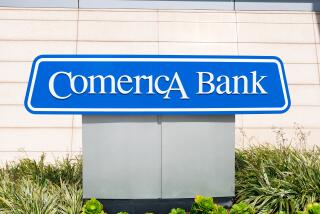Bank failures: FDIC charts striking improvement in industry’s health
- Share via
This chart from the Federal Deposit Insurance Corp.’s latest report on the banking industry paints a picture worth more than a few thousand words about the recovery from the financial crisis.
Outright bank failures peaked in 2009, when 140 banks collapsed, and 2010, when regulators closed 157. They then dropped sharply, with only 16 going under during the first half of this year. (Four more failed this month, bringing the total so far in 2013 to 20.)
But damage from the crisis lingered much longer. The number of banks on the FDIC’s “problem list” -- those presumed to be in danger of collapse -- only started to decline in 2011.
PHOTOS: Failures that drained deposit-insurance funds
The number of these wobbly banks fell from 612 in the first quarter of this year to 553 in the second quarter -- down nearly 40% from the first quarter of 2011, when they peaked at 888.
The FDIC’s deposit-insurance fund -- once the subject of much speculation about a bailout -- saw its balance rise to $37.9 billion as of June 30, up from $35.7 billion at the end of March.
The last bank collapses in California, once a hotbed of failures, occurred in April 2012, when Pacific Premier Bank in Palm Desert was shut down, and September 2011, when Citizens Bank of Northern California in Nevada City went under.
Still, the 553 troubled institutions nationwide in the FDIC’s latest count -- out of the nearly 7,000 U.S. banks that remain in business -- is not exactly a low number. Which banks are on that list of the troubled? Don’t ask the FDIC -- it will never tell.
ALSO:
FDIC prepares to go after officials at failed banks
FDIC settlements with bank insiders go unannounced
In reversal, FDIC reveals settlements linked to financial crisis
More to Read
Inside the business of entertainment
The Wide Shot brings you news, analysis and insights on everything from streaming wars to production — and what it all means for the future.
You may occasionally receive promotional content from the Los Angeles Times.











